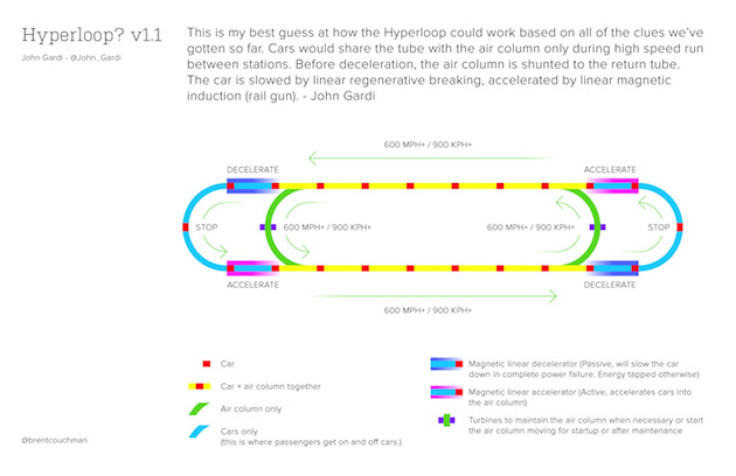Hyperloop Coming, But How? Technical Breakdown Shows Elon Musk's Project Is Possible

Tesla Motors Inc. (NASDAQ: TSLA) and SpaceX CEO Elon Musk dropped mysterious hints throughout July about “The Hyperloop,” a new high-speed transportation system that he says will take riders from Los Angeles to San Francisco in under 20 minutes and cost one-tenth of the price of the proposed bullet train from L.A. to S.F. Musk announced that he would reveal the plans by Aug. 12, but that didn’t stop designers from creating mockups predicting how the Hyperloop technology could work.
John Gardi, a “tinkerer and jack-of-all-trades currently living in Canada,” according to Motherboard, designed a mockup of the Hyperloop that Musk praised for being the “best guess” he’d seen yet. Gardi elaborated on his Hyperloop design, which Musk describes as a cross between a Concorde supersonic plane, a rail gun and an air hockey table, to give an idea of the technology needed to actually build a Hyperloop, and how it would actually be a cost-effective project.

Using some clues from Musk, Gardi determined that each Hyperloop car would be roughly the same size and weight as a family car. He extrapolated from this the maximum weight the Hyperloop’s main structure could support. Gardi concludes that because a high-speed rail car would be nearly 20 times heavier, the construction of the Hyperloop would be cheaper and the components would be stronger.
@John_Gardi your guess is the closest I've seen anyone guess so far. Pod diameter probably around 2m
- Elon Musk (@elonmusk) July 15, 2013
Gardi says this difference in weight will make it possible for the Hyperloop to be an elevated structure, which will ultimately reduce costs by avoiding the pitfalls of ground-level rail. It will be easier for the Hyperloop to avoid both manmade and natural obstacles, and completely avoid digging tunnels. It could also lease out farmland and make contracts with communications companies like Google that might be interested in using the structure to expand fiber optic cables.
With that in mind, Gardi proposed a Hyperloop that consists of concrete footings set into the ground every 300 feet, with pylons on top that range from 40 feet to 100 feet tall. Nine-foot wide and 300-foot tall trusses will span the top of the pylon to support the tube sections, which will be roughly 18 feet wide and 9 feet tall.
To minimize the weight of the Hyperloop, Gardi suggested composite sewer pipe. It’s inexpensive, already produced in the right size and can handle far more weight than necessary for the Hyperloop.
Finally, Gardi even explores how Musk’s company could go about constructing the Hyperloop. The first step would be the footings and the pylons. After the first truss is placed on top of two pylons it can be used as a platform to construct the rest of the Hyperloop using a crane.
“The speed of laying trusses is limited only by the speed of the crane and the efficiency of the supply chain,” Gardi wrote in Motherboard. “By adding an extra component to the overall design, we’d save money over the entire project and not just construction phase either! Those trusses would more than pay for themselves by an order of magnitude compared to any other construction method!”
Tesla Motors, Musk’s electronic car company, will report its earnings after markets close Wednesday. Analysts expect the company to report $18.8 million, or 17 cents per share, on $383 million in revenue.
What do you think of Gardi’s prediction on the construction of the Hyperloop? Will it make Musk’s claims of high-speed, low-cost transportation possible? Let us know in the comments section.
© Copyright IBTimes 2024. All rights reserved.












